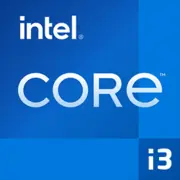Intel Core i3-12100T

Intel Core i3-12100T: A Budget Processor for Office Use, Multimedia, and Beyond
March 2025
Introduction
Intel's Core i3 processors have always served as the starting point for budget PCs, and the model i3-12100T stands out even among them. Built on the hybrid Alder Lake architecture, this chip combines low power consumption with adequate performance for daily tasks. In 2025, it remains relevant for office systems, media centers, and compact builds. Let’s explore why.
Key Specifications
Alder Lake Architecture and Intel 7 Process
The i3-12100T is based on the Alder Lake architecture, which introduced hybrid cores (P-cores and E-cores) for the first time. However, this model features only 4 P-cores (8 threads) — E-cores are absent, simplifying its structure and reducing costs. The Intel 7 process (10nm Enhanced SuperFin) ensures high energy efficiency, with a base power consumption (TDP) of only 35 Watts.
Performance
- Frequencies: Base clock – 2.2 GHz, maximum turbo boost – 4.1 GHz.
- Cache: 12 MB L3.
- Graphics: Integrated GPU Intel UHD Graphics 730 (base clock – 300 MHz, dynamic – 1.45 GHz).
- Benchmarks: In Geekbench 6, the processor scores 1935 points in single-threaded and 5793 in multi-threaded tests. For comparison, this performance level is on par with the Intel Core i5-10400 (Comet Lake), but with a lower TDP.
Key Features:
- Support for PCIe 5.0 (maximum compatibility with new SSDs).
- Intel Thread Director technology (stream optimization for Windows 11).
- Hardware protection against vulnerabilities (Shadow Stack, Control-Flow Enforcement).
Compatible Motherboards
LGA 1700 Socket and Chipsets
The processor uses the LGA 1700 socket and is compatible with the following chipsets:
- H610 — budget option (DDR4, PCIe 4.0, no overclocking). Example: ASUS Prime H610M-E ($75-90).
- B660 — optimal choice (DDR4/DDR5, PCIe 5.0 for GPUs). Example: Gigabyte B660M DS3H ($110-130).
- H670/Z690 — for enthusiasts (more USB/SATA ports, memory overclocking).
Selection Notes:
- There’s no point in choosing an expensive Z690 for the i3-12100T since the chip does not support overclocking.
- If DDR5 is required, choose a B660 that supports this standard (e.g., MSI PRO B660-A DDR5).
Supported Memory Types
The processor works with:
- DDR4-3200 (cheap modules, e.g., Kingston Fury Beast 16 GB – $40).
- DDR5-4800 (faster but more expensive: Corsair Vengeance 16 GB – $70).
Recommendations:
- DDR4 is sufficient for office tasks and multimedia.
- DDR5 is only justified in builds with a discrete graphics card for gaming or graphics work.
Power Supply
With a TDP of 35 Watts, the i3-12100T is one of the most "power-efficient" desktop processors. However, it's important to note:
- Systems without a discrete graphics card: A power supply of 300-400 Watts is sufficient (e.g., be quiet! Pure Power 11 400W – $60).
- With a graphics card like the NVIDIA RTX 3050: A power supply of 500-600 Watts (EVGA 600 W1 – $65).
Important: Even low-end PSUs like the FSP Hyper 500W ($45) can handle it, but it’s better not to skimp on quality (risk for stability).
Pros and Cons
Pros:
- Energy efficiency: ideal for compact cases and passive cooling systems.
- High single-threaded performance: quick responsiveness in browsers and office applications.
- Presence of UHD 730: can run games like CS2 at low settings (720p, 40-50 FPS).
Cons:
- Only 4 cores: insufficient for rendering or streaming in 2025.
- No PCIe 5.0 support for SSDs (only PCIe 4.0 x4).
- Overclocking is not supported.
Use Cases
Office and Multimedia
- Document work, video conferencing, streaming 4K (Netflix, YouTube) — the processor handles it without lag.
- Example: Connecting to a 4K monitor via HDMI 2.0.
Gaming
- With a discrete graphics card (e.g., NVIDIA GTX 1660 Super): Fortnite at medium settings (1080p, 60 FPS).
- Without a graphics card: Minecraft, Dota 2 (720p, 30-40 FPS).
Work Tasks
- Photo editors (Lightroom): processing RAW files takes 15-20% longer than on an i5-12400.
- Programming: comfortable work in IDEs (VS Code, IntelliJ).
Comparison with Competitors
AMD Ryzen 5 7500F ($140-160):
- Pros: 6 cores, DDR5 support, better performance in multi-threaded tasks.
- Cons: No integrated graphics, TDP of 65W.
Intel Core i5-12400T ($180-200):
- Pros: 6 cores, higher clock speed (4.6 GHz), better suited for gaming.
- Cons: Price is 40% higher.
Conclusion: The i3-12100T only wins in the budget segment (up to $150) and when low TDP is a requirement.
Practical Assembly Tips
1. Motherboard: Choose B660 with DDR4 if you don’t plan on upgrading. Example: MSI PRO B660M-A WiFi ($130).
2. Cooling: The stock cooler is sufficient, but for quieter operation, consider the DeepCool Gammaxx 400 V2 ($25).
3. Storage: SSD NVMe is a must (e.g., Kingston NV2 500 GB – $35).
4. Case: For a compact build, the Fractal Design Core 1100 is suitable ($50).
Final Verdict: Who is the i3-12100T Suitable For?
This processor is an option for those who:
- Are building a budget office PC or home media center.
- Seek energy efficiency (e.g., for mini-PCs or servers).
- Have a limited budget ($120-140 for the processor + $300-400 for the entire build).
In 2025, the i3-12100T remains relevant due to its low price and sufficient performance for basic tasks. However, for gaming or professional workloads, it's better to consider models with 6 cores.
Basic
CPU Specifications
Memory Specifications
GPU Specifications
Miscellaneous
Benchmarks
Compared to Other CPU
Share in social media
Or Link To Us
<a href="https://cputronic.com/cpu/intel-core-i3-12100t" target="_blank">Intel Core i3-12100T</a>